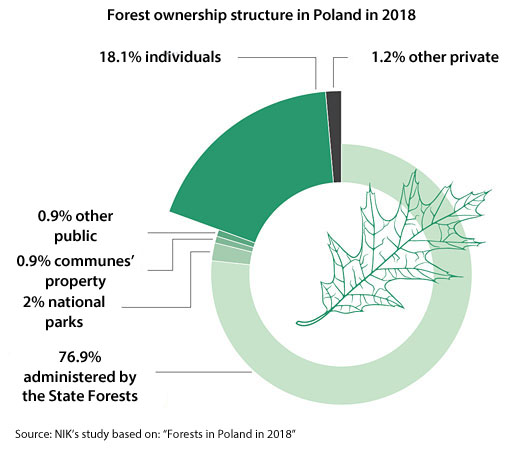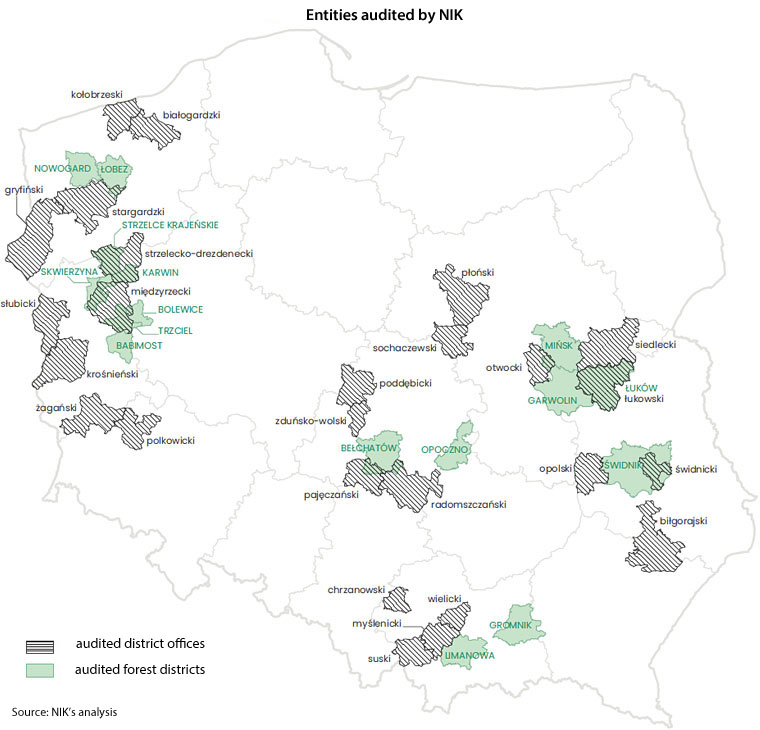Poland is one of six EU member states with the largest forest areas. Public forests prevail in the forest ownership structure in Poland. Nevertheless, in 1990-2017, the share of private forests went up by 2.3 percentage points.

The Forest Act imposes the whole range of obligations on forest owners, including forests not owned by the State Treasury. They are related to forest protection rules, forest maintenance regularity, continuity and sustainable use of all forest functions and principles of expanding forest resources. Efficient supervision in the key element of this system. The forest management supervision in private forests stands for both administrative supervision and measures addressed to forest owners – support and assurance that their statutory tasks and obligations will be performed. A characteristic feature of non-public forests is the fact that they are significantly fragmented and dispersed, which makes forest supervision more difficult.

Key audit findings
Only one third of the audited district offices had simplified forest management plans and forest inventories for the whole or nearly whole area of forests covered by the supervision. District governors did not take effective steps when simplified forest management plans were not developed by forest owners other than sole legal owners or co-owners. That made the supervision difficult or even impossible. In some cases, no decisions concerning forest management tasks were issued, although the forest inventory was made.
In the audited district offices, simplified plans were approved in an inconsistent manner. The reason was the absence of relevant provisions in the Forest Act. It happened that forest owners were not familiarised with the content of the plans. Frequently, they were not informed about concluded agreements. According to NIK some forest owners could have no idea who supervises forest management in their area. Also, they could be uncertain where to find such information.
No inspections were planned in the audited district offices to establish how forest owners discharge their obligations. In half of the audited district offices, in the cases where agreements were not concluded, reliable or active supervision was not in place. Inspections were often made on the occasion of other field works, in particular related to timber legality. The lack of reliable, active and on-going supervision was mainly caused by staff shortages or the lack of special equipment for forest work. According to NIK, the lack of decisive administrative and enforcement measures could translate into weaker sense of obligation to comply with the law by forest owners.
The audited district offices usually did not enforce the communes’ obligations (as forest owners) to keep balance in forest ecosystems, increase natural immunity of tree stands, maintain forests on a permanent basis and ensure continuity of their use. Only in one district all communes took such measures. On average more than 70% communes in the audited districts did not perform those tasks. In six districts there was not a single commune that did that.
Besides, proper attention was not given to forest fire protection. In one fourth of the audited district offices employees did not know if the forest owners met that obligation. The NIK audit revealed that the draft plans often lacked information about the fire risk category. The district governors often approved simplified forest management plans without consulting their drafts in the fire protection section with the State Fire Service. Also, the placement of information and warning boards at forest entry gates and on forest parking places needs to be consulted with the district commanders of the State Fire Service. Required consultations were made only in one of 24 audited districts. It is worth noting that the total number of non-public forest owners (or co-owners) reach a few hundred thousand.
At the request of NIK, the State Fire Service conducted 44 ad hoc audits on fire protection provisions in forests other than owned by the State Treasury. Irregularities were found in 9 of 24 audited districts.
NIK has found numerous irregularities related to the timber acquisition process. In nine of 24 audited districts the timber legality certificates were completed incorrectly. Only in three district offices timber was acquired in line with the relevant documentation. In one district, where protected areas Natura 2000 were located, the forest owners acquired over 23.5 thousand m3 of timber from non-public forests without simplified forest management plans or forest inventories.
Estimates provided in the document “Large-area forest inventory” show that in 2015-2019, about 5 million m3 of the so-called large timber was acquired yearly in private forests. According to GUS data, the average annual acquisition of large timber totalled 1.5 million m3. The above may indicate that 3.5 million m3 of timber is acquired yearly (without the legality certificate) of estimated value of about PLN 676 million per year.
NIK also identified a conflict of interests in some district offices. In 11 of them, an employee who was to supervise forest management or their superior (even the district governor) was the owner or co-owner of the supervised forest. In one case an employee prepared the timber legality certificate for themselves. Only in seven district offices required provisions on the conflict of interests were included in the Code of Ethics.
The law allows district governors to accept the conversion of forestland into agricultural land. Nearly half of such examined decisions contained significant errors or were taken after improperly conducted proceedings. In extreme cases forestland was converted e.g. into construction areas without considering the obligatory decision of the regional director for environmental protection.
The audit revealed several causes of irregularities in private forests supervision. Those were mainly insufficient funds in district offices’ budgets, improper preparation in terms of organisation and personnel, ignoring duties.
The auditees’ employees pointed to issues which made it difficult to exercise the supervision. They included among others:
- forest parcels were fragmented and dispersed a lot, the area per one owner was relatively small;
- private and state-owned land mixed with each other;
- property borders were not marked;
- legal status of many forest properties was not settled;
- forest owners lacked knowledge of forest management and applicable law.
Recommendations
NIK has underlined the importance of implementing new regulations to allow district governors to supervise forest management in the forests having district borders on their area. Implementation of the following provisions should be considered, among others: indicating the data provision mode, task financing principles, informing forest owners about the authority’s local property, as well as provisions making sure forest owners other than sole legal owners or co-owners discharge their obligations to commission the development of simplified forest management plans.
In view of the above NIK has addressed relevant recommendations to the Minister of Climate and Environment and the Minister of Internal Affairs and Administration.


